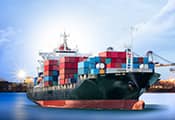Importance of Pallet Shipping in Global Trade & Logistics
In light of the expansion of the global trade scenario, pallet shipping is critical for ensuring safe, efficient, and cost-effective goods transportation. Let's take a look at the below pointers for more clarity:
- Pallets make it easy to store, load, and unload products. These also minimise the chances of damage while standardising cargo handling.
- They improve the efficiency of the supply chains by facilitating faster movement of cargo via warehouses, ports, and distribution hubs.
- Furthermore, palletised shipments help optimise space in containers and trucks. This often reduces shipping costs and environmental footprint.
- Standard pallet sizes are more compatible with automated systems. This helps boost operational efficiency.
- Pallet shipping also facilitates smooth transactions and timely deliveries across borders while ensuring seamless international logistics.
How Pallet Shipping Works?
Refer to the below table to understand how pallet shipping works:
| Category |
Description |
| Loading and Securing Goods |
Arranging goods properly on pallets is important for safety and efficiency. Let's check out how it’s done:
- Stacking: Heavier items always go at the bottom and the lighter ones come on the top. It ensures proper weight balance.
- Uniform Distribution: Weight distribution should be even to prevent collapsing or tilting.
- Securing the Load: Loads are secured with stretch wrap, shrink wrap, and strapping to keep items in place.
- Protection: Using corner protectors and cushioning materials helps prevent damage during transit.
|
| Pallet Types |
There are different types of pallets for different cargo and transportation needs:
- Wood Pallets: These are widely used for being cost-effective and easy to repair. It is used for shipping, warehousing, retail, and manufacturing.
- Plastic Pallets: These are ideal for food and pharmaceutical industries due to their sturdiness, moisture resistance, and hygiene.
- Metal Pallets: These are strong and durable and are used mainly for heavy-duty and industrial items.
|
| Transportation Methods |
Pallets can be shipped using various modes of transportation:
- Road Freight: Moving pallets via trucks and trailers is a good choice for local and regional transport.
- Rail Freight: It is a cost-effective option for bulk goods over long distances.
- Sea Freight: Waterways are ideal for international shipping through containers.
- Air Freight: It is one of the fastest but most expensive options. It is suitable for urgent or high-value loads.
|
Learn more about Marine Insurance
Types of Pallets Used in Shipping
Let's take you through the different types of pallets used in shipping and their pros and cons:
| Type of Pallet |
Pros |
Cons |
| Wooden Pallets |
- It is cost-effective and widely available
- It is easy to repair and recycle
- It is good for carrying heavy loads
|
- It is prone to crack, break, and absorb moisture.
- It is also prone to pest infestation and may require heat treatment for international shipments.
- It is not as durable and long-lived as its plastic or metal counterparts.
|
| Plastic Pallets |
- It is highly durable and resistant to moisture, harmful chemicals, and pests.
- It is lightweight and reusable. Hence, it is cost-effective.
- It does not need heat treatment for international shipping.
|
- It is more expensive (initial cost) than wooden pallets.
- It is difficult to repair if damaged.
- It is less biodegradable but can be recycled.
|
| Metal Pallets |
- It is sturdy, strong and capable of bearing heavy loads.
- It is resistant to extreme weather, chemicals, and fire.
- It offers high longevity and requires low maintenance.
|
- It is expensive with respect to the initial investment.
- As it is heavier than other options, the transportation costs are often higher.
- It is prone to corrosion or rusting if not treated properly.
|
| Presswood Pallets |
- It is lightweight. Hence, its shipping costs are reasonable.
- It is eco-friendly because it is made from recycled materials.
- It has a nestable/stackable design that saves storage space.
|
- It is less durable than traditional pallets.
- It can absorb moisture quickly, leading to weakening and swelling of the pallet.
- It has a limited load-bearing capacity.
|
Related: What are High Cube Containers in Shipping?
Benefits of Pallet Shipping
There are many benefits of pallet shipping. Read on the following pointers for details:
Efficient Loading and Unloading
Pallets are easy and quick to move through pallet jacks or forklifts, so a large number of goods can be moved in a short span. This, in turn, helps save on handling time and labour costs.
This efficiency also speeds up the shipping and receiving process while reducing the odds of delays. It improves overall productivity across warehouses and distribution hubs.
Protects Goods from Damage
Pallets are sturdy and strong structures and make stacking stable and secure. This minimises the risk of product damage during transit. Also, they keep the commodities off the ground, which prevents exposure to dirt, moisture, and possible smashing.
Another important thing is that the goods are secured tightly with strapping or shrink-wrapping within the pallets, keeping them intact and unharmed on the go.
Cost-Effective
Palletised shipping makes space optimisation easy inside the storage containers. It allows for more efficient and cost-effective transportation and eliminates the need for multiple shipments.
Pallet shipping also makes cost savings easy by reducing the risk of damage and handling resources.
Easier Tracking and Handling
Standardised pallet sizes and shapes improve logistics by streamlining the loading, unloading, and storage process.
Many modern supply chains use barcodes, RFID tags, or QR codes on pallets. These tags help in better inventory management and real-time shipment tracking.
Factors to Consider When Choosing a Pallet for Your Goods
Before choosing a pallet for your goods, it is always a good idea to consider the following factors:
| Factors |
Key Considerations |
| Pallet Material |
- Wood: These are cost-effective but are prone to damage and breakage.
- Plastic: These are durable and hygienic.
- Metal: These are heavy-duty but expensive.
- Composite: These are lightweight and eco-friendly but not as strong as their counterparts.
Note: Choose a pallet that fits your goods and shipping requirements.
|
| Pallet Size |
- The standard sizes of pallets differ depending on region. For example, in the US, the standard is 48" x 40”, whereas, in Europe, it is 120x80 cm.
- You may also tailor the size if you have any specific storage or handling needs or if the dimensions of your items are non-standard.
Note: Ensure your pallet size is compatible with transport and storage systems.
|
| Load Capacity |
- Static Load: It is the weight a pallet can carry when standing.
- Dynamic Load: The weight the pallet can endure during movement. It is usually lower than the static load capacity.
Note: Make sure to consider the weight the forklift or pallet jack can hold and the impact of handling on the load capacity of the pallet.
|
| Nature of the Product |
- Fragile Items: When shipping delicate items, choose pallet material that offers sufficient cushioning. It includes - metal or plastic.
- Heavy Items: For heavy goods, choose a durable pallet material, such as metal or reinforced wooden pallets.
- Perishable Goods: If your items are perishable, choosing easy-to-clean materials, such as plastic, is a good idea. Also, select a pallet that offers proper ventilation.
Environmental Conditions - Always choose a pallet material that can tolerate environmental conditions, such as moisture, temperature, UV exposure, or pests.
|
| Cost and Durability |
- Initial Cost: Always factor in the initial cost of the pallet, as well as the long-term cost of ownership, including potential repairs or replacements.
- Durability: Choose a pallet that can take the ups and downs it goes through during handling and transportation.
- Reusable vs. One-Time Use: Make sure you know if you need a reusable or one-time-use pallet.
Note: Higher upfront costs may lead to long-term savings.
|
Challenges in Pallet Shipping
The following are some of the most common challenges in pallet shipping:
- Weight and Size Limits: Different transport modes have different weight and size-related constraints on pallets. Exceeding these specific limits may call for additional expenses, logistical issues, or even load rejection.
- Pallet Quality Issues: Damaged, feeble, low-quality pallets can damage product during transit.
- Customs and Regulatory Compliance: Shipments are bound to adhere to the customs regulations and the pallet treatment norms. Filing to comply may result in fines, delays, or even confiscation.
- Space Constraints: Poor stacking and improper load optimisation will likely create wasted space in warehouses or shipping containers. It may lead to higher storage and transportation costs and hamper the overall efficiency of the supply chain.
Best Practices for Pallet Shipping
Let's take a quick look at the best practices for pallet shipping to ensure safety, efficiency, and cost-effectiveness are in place:
- Choose the Right Pallet Type: Select the pallets according to the product to be shipped and the shipping destination. It will help you meet durability and compliance standards.
- Use Stretch Wrap and Strapping: Properly fasten the goods with a high-quality stretch wrap or strap to prevent movement or damage during transportation.
- Label Clearly: Ensure proper and clear labelling. This helps with correct identification and tracking and eases the process of customs clearance.
- Follow Weight Distribution Guidelines: Evenly spread the weight across the pallet. It will prevent tipping and damage.
How Marine Insurance Supports Pallet Shipping?
Marine insurance plays an important role in pallet shipping. Let's take you through the benefits of marine insurance:
- Covers damage or loss of goods during transit: Marine insurance covers the possible damage or loss that may happen in transit, regardless of the mode of transport.
- Protects against various risks: A good insurance policy is likely to cover a wide range of risks, such as theft, fire, transit-related accidents, and natural disasters, while saving your finances from the unforeseen.
- Ensures financial recovery for damaged or lost shipments: Many marine insurance plans compensate a business for lost or damaged shipments. It helps them minimise financial losses and ensure stability of the supply chain.
Conclusion
Pallet shipping is important for safe, efficient, and cost-effective transportation. It ensures proper stacking, easy handling, and space optimisation. Moreover, it also helps streamline supply chains and reduce the risk of transit-related damage. However, always make sure to choose the right pallet type. It is the most important consideration to ensure the safety, durability, and compliance of the shipment.
Another crucial aspect related to pallet shipping is marine insurance. It plays a vital role in guarding against shipping risks. It covers potential losses due to theft, accidents, or natural disasters. Simply put, the combination of shipping via pallets and marine insurance ensures smooth, reliable, and financially secure global trade and logistics.
































 Expert advice made easy
Expert advice made easy


